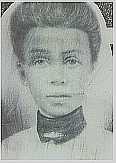Sign up for the Family Tree Newsletter Plus, you’ll receive our 10 Essential Genealogy Research Forms PDF as a special thank you!
Get Your Free Genealogy Forms
"*" indicates required fields

What’s going to happen to your photographs? When there is a death in the family, relatives may divide up the pictures. If no one wants them, photographs—especially unidentified ones—can end up being discarded or sold by whoever receives the leftover belongings. You can prevent your family’s photographic heritage from being lost by making sure that you identify the images. It also helps to pass on the information to family members who are going to inherit the pictures. If you want to add images to your existing collection, let older relatives know that you would be happy to take care of their photographs. Unfortunately, this doesn’t always happen, and along with the memories, so go the family photographs.
In the 1950s, Leonard Clark Sr.’s father let him make a charcoal tracing of an original photograph of his grandmother, Lucintha (Dye) Clark. His father identified the picture but didn’t relate any other information. When his father died in 1981, relatives divided up his photograph collection. As inevitably happens, some photographs were lost, including the original that this drawing was made from. Leonard submitted the photograph to this column to find out more about the image.
Lucintha (Dye) Clark, born in 1863 in Missouri, was raised by Martin and Caroline (Aunt) Callie Dye, one of the families belonging to Henry C. Dye of Arkansas. Born in the midst of the Civil War, her birth year coincided with the passage of the Emancipation Proclamation that decreed slaves in Confederate states would be free as of Jan. 1, 1863. The relationship between the Dyes and Lucintha does not exist in any documentation, but according to family, there was a strong emotional bond between them. Lucintha married Stephen Clark in 1878 in Bird County, Arkansas. They had eight children. She died in 1913 in Newport, Ark.
One of Leonard’s questions was whether this picture was a wedding portrait. Since this is not the original photograph, there are many missing details, such as the name of the photographer and the photographic method. Fortunately, there is just enough detail in this drawing to be able to date it. Her upswept hair and pleated blouse place the image within the 1895 to early 1900 time frame. The black area around her neck is not part of her dress or blouse but is probably a black ribbon used to provide contrast and heighten her neckline. I’ve seen other photographs of the same time period, where women selected scarves and ribbons to create this effect. It is not a wedding portrait since she married a couple of decades before this picture was taken.
Leonard Clark has taken steps to recreate the family photograph collection, by developing a Web site. On it he has posted all his historical family photographs. He also invites family to add genealogy and photography to this site. It has become a way to communicate with his family in words and pictures. By accumulating the photographic heritage of his family, he is increasing his chances of rediscovering the original photograph of Lucintha (Dye) Clark. (Read more about filling in the gaps in your family photo collection in the April issue’s Getting the Picture.)
It’s wonderful to be able to plan for the future by sharing family photographs with an interested relative now or by adding a clause to your will. Remember that your photographs are as important to your genealogy as the pages of a family bible. They tell the visual story of your family. Once they are gone, a whole piece of your family history is missing. Don’t wait until it’s too late, start sharing pictures with relatives today.
ADVERTISEMENT

